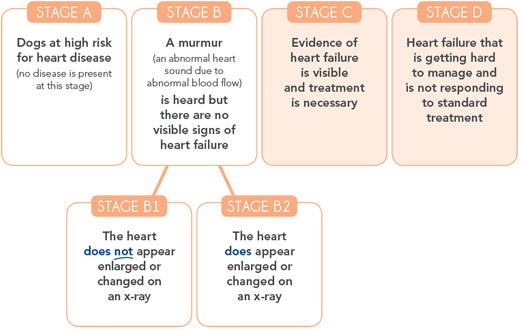Everyday Medicine: Heart disease grading scale for dogs

Everyday Medicine: Heart disease grading scale for dogs
“Everyday Medicine” is an intermittent series of blog posts highlighting tests, treatments and procedures common in daily Animal Medical Center practice. Some past examples of this type of blog post include fecal examination and vomiting or regurgitation. Today’s post focuses on the scale used by AMC cardiologists to define the severity of heart failure.
The veterinary community often uses grading scales to describe the severity of a disease to streamline communication between vets and standardize treatment protocols. For example, when diagnosing canine chronic valvular heart disease (CCVD), veterinarians use the American College of Veterinary Internal Medicine (ACVIM), Specialty of Cardiology’s guidelines, which are modified from the human heart disease classification system. This scale helps veterinarians delay the onset of heart failure in your dog by optimizing the medication plan.
In this post, I’ll explain the different stages of CCVD that your dog’s cardiologist may discuss with you.
Canine heart disease
There are two general forms of canine heart disease: abnormalities of the heart muscle (cardiomyopathy) and abnormalities of the heart valves (CCVD). According to data collected by primary care practices, ten percent of dogs have CCVD. The grading scale discussed in this post addresses only dogs with CCVD.
Stage A
This stage is the silent form of CCVD. So why is it a stage? It indicates dogs that may be at high risk for CCVD. CCVD is common in small breed dogs, so owners of Cavalier King Charles Spaniels, Dachshunds and Miniature and Toy Poodles should be sure their dog has a cardiac auscultation (listening to the heart with a stethoscope) as part of a regular physical examination.
Stage B
Dogs move from Stage A to Stage B when a heart murmur is auscultated. When a heart murmur is identified, additional cardiac testing may be recommended by the primary care veterinarian. Stage B has two substages: B1 and B2. A chest x-ray is used to differentiate between the two substages. Dogs with a normal sized heart, as determined by x-rays, have B1, and dogs with enlarged hearts have B2. When dogs shift from B1 to B2, many cardiologists will recommend starting heart medications.
Stage C
Stage C occurs when CCVD worsens and leads to congestive heart failure where fluid builds up in the lungs (pulmonary edema), causing labored breathing. Pulmonary edema is diagnosed with a chest x-ray. When congestive heart failure occurs, water pills (diuretics) and other medications are added to the treatment plan.
Stage D
Stage D is the most advanced stage of CCVD. Dogs with Stage D CCVD require additional drugs to control pulmonary edema, and heart failure becomes more difficult to control. Dogs with Stage D CCVD often lose weight despite consuming adequate calories due to a phenomenon known as “cardiac cachexia,” the loss of body fat and muscle as a result of chronic heart failure. This stage of heart failure affects quality of life for both the dog and the family.
The Animal Medical Center has three board certified cardiologists and this simple staging system helps them to provide life-saving care every day.































